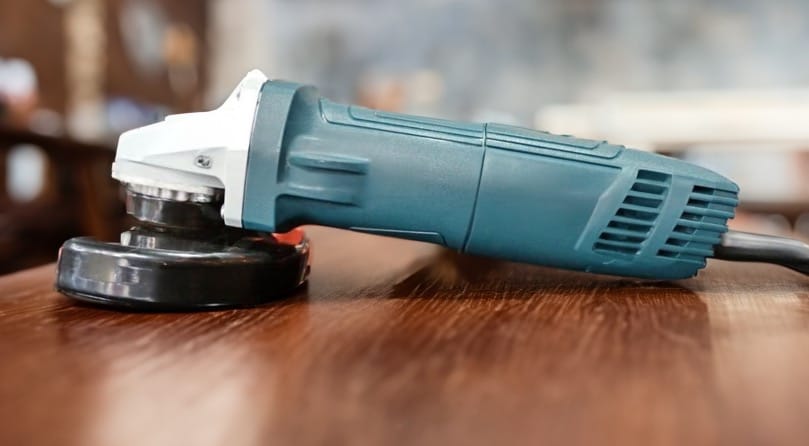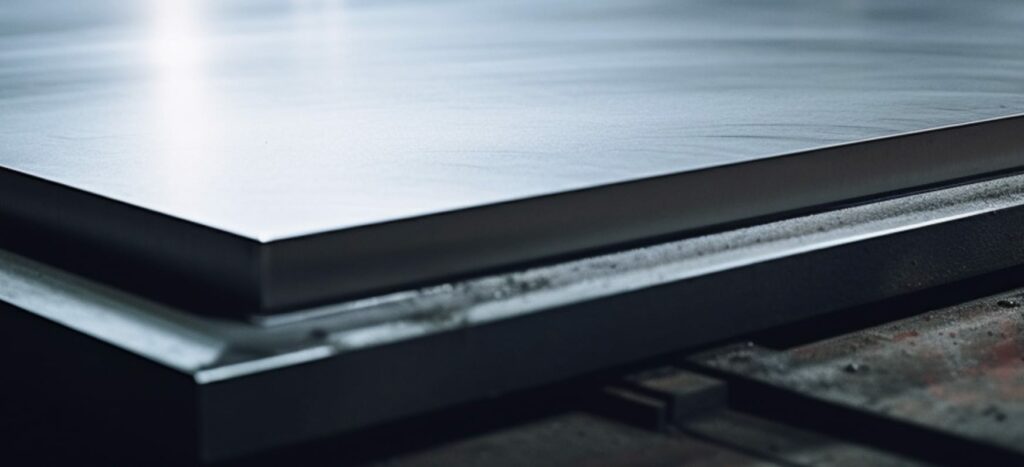Angle grinders are powerful, versatile, but also a bit intimidating tools, particularly because of their power.
But, even though they are powerful, are these tools powerful enough to cut thick steel?
That’s why I’ve put together this guide we’re I’ll dive deep into the world of angle grinders and thick steel.
I’ll show you how to pick the right angle grinder to cut thick steel, and what kind of “frisbee” (read: disc) you should use, and how to do it without turning your workshop into a mess.
So, let’s get it going!
Why Choose an Angle Grinder for Cutting Thick Steel?
You’re probably wondering why you should even consider an angle grinder for cutting thick steel.
I mean, it’s easy to see how an angle grinder can cut thin steel sheets and other materials too.
But… thick steel?
You might be thinking, “Shouldn’t I be using something more heavy-duty, like a plasma cutter or a band saw?”
Well, let me tell you, there are a couple of solid reasons why angle grinders are more than up to the task of cutting thick steel.
What Makes Angle Grinders So Great?
- Versatility: An angle grinder is a jack-of-all-trades in your toolbox. It’s not just for cutting; you can use it for grinding down rough edges, polishing surfaces, and even sanding if you swap out the disc.
- Reliability: These tools are a staple in various industries for a reason. They’re reliable and get the job done, especially when it comes to thick steel.
- Power: The motor in an angle grinder is robust enough to handle thick materials. With the right disc and enough horsepower, you can cut through thick steel like it’s a piece of cake.
Now, why are these features essential for cutting thick steel in particular?
Thick steel requires a tool that can deliver consistent, high power without overheating. An angle grinder can do just that, especially if you pick one with a strong motor.
Its versatility also means you can do more with a single tool, saving you time and effort in the long run.
When You Might Want to Skip the Angle Grinder
Before we go all-in on angle grinders, let’s talk about when they might not be the best choice.
- Not for Detail Work: If you’re looking to carve your initials into a piece of metal, an angle grinder isn’t your tool. It’s built for heavy-duty tasks and doesn’t offer the precision needed for intricate work.
- Safety is a Big Deal: I can’t stress this enough. An angle grinder is a powerful tool, and you’ve got to respect that power. Mishandling it can lead to serious accidents, so always prioritize safety. So, if you’re someone who doesn’t like to wear protective safe-wear, then this tool might not be for you
Selecting the Right Disc for Cutting Thick Steel
You’ve got your angle grinder, but that’s only half the battle.
The disc you choose is just as crucial, especially when you’re dealing with thick steel.
I mean, the right disc can make or break your project. You don’t want to waste time and money on the wrong one, especially when you’re dealing with something as unforgiving as thick steel.
So I’d say considering the following factors might be a nice idea:
Type of Metal
Knowing the type of steel you’re working with is crucial because different steels have different hardness levels and other properties.
For instance, if you’re cutting stainless steel, you’ll want a disc made of aluminum oxide, as it’s great for harder materials.
On the other hand, if you’re dealing with mild steel, a general-purpose disc might just do the trick.
Pro-tip: Always identify the type of steel you’re working with before you start. Then, match it with a disc that’s designed for that specific metal. If you’re unsure, consult the manufacturer’s guidelines for the disc, or even better, do a test cut on a scrap piece of the same material.
Cutting Depth
If you’re slicing through a thick slab of steel, you’ll need a disc that can handle that depth without wearing out too quickly which is why knowing the depth of the cut beforehand you want to make is key.
I mean, the last thing you want is to be halfway through a cut and have your disc give up on you.
Pro-tip: Measure the thickness of the steel you’ll be cutting and choose a disc that’s rated for that depth. Always go for a disc that can handle a bit more than you think you’ll need; it’s better to have too much capability than not enough.
Type of Cut
The type of cut you’re planning to make also plays a role in your disc selection.
I mean, if you’re making straight cuts, most discs will do the job. But if you’re planning on doing more intricate work, like cutting out patterns or making curves, you’ll need a disc that offers more precision.
Pro-tip: For straight cuts, a standard metal-cutting disc is usually sufficient. But for more intricate work, consider a disc with a thinner profile for better precision. Just remember, thinner discs wear out faster, so have a few extras on hand if you’re planning a lot of detailed cuts.
Types of Discs Suitable for Cutting Thick Steel
So, what types of discs are suitable for cutting steel?
General-Purpose Discs
They can handle a variety of tasks, from cutting to grinding.
But when it comes to thick steel, they might not be up to the task.
They’re often made of less durable materials and might wear out quicker than you’d like.
So, in short, general-purpose discs are great for lighter tasks, but if you’re dealing with thick steel, you might want to look elsewhere.
Specialized Metal-Cutting Discs
Specialized metal-cutting discs usually feature a resinoid bond that makes them tough and durable.
The materials used to manufacture them, like aluminum oxide or silicon carbide, are chosen for their ability to handle hard metals.
So, if you’re cutting thick steel, do yourself a favor and go for a specialized metal-cutting disc.
Also, check the packaging or manufacturer’s website to make sure it’s suitable for the type of steel you’re cutting. These discs might cost a bit more, but they’ll save you time and frustration in the long run.
Disc Thickness
So, what types of disc thickness are there to select for cutting thick steel with your angle grinder?
- Ultra-Thin Discs: These are great for precision cuts but might not be the best for thick steel. They can wear out quickly.
- Thicker Discs: These are your workhorses. They can handle the depth and the toughness of thick steel but might be overkill for thinner materials.
Cutting Thick Steel With Angle Grinder Safely
Before you even think about turning on that angle grinder to cut thick steel, let’s talk about how to keep all your fingers and toes where they belong, shall we?
What Safety Gear to Wear?
When you’re dealing with a tool as powerful as an angle grinder, especially for cutting thick steel, safety gear isn’t optional—it’s a must.
You’re not just dealing with a noisy machine; you’re also dealing with:
- Flying Metal Shards: These can shoot out at high speeds and are a real hazard.
- Sparks and Hot Metal: The grinding process can produce these, and you don’t want them landing on your skin or in your eyes.
- Loud Noise: Prolonged exposure to high decibels can lead to hearing loss over time.
But, what type of safety gear should you wear? Well, I’d tell you to:
- Safety Glasses: These are non-negotiable. The last thing you want is a flying shard of metal in your eye.
- Face Shield: This is like the big brother to safety glasses. It protects your entire face, not just your eyes.
- Hearing Protection: Angle grinders are loud. Like, really loud. Protect those ears, folks.
Always, and I mean always, wear your safety gear. No excuses. If you don’t have the right gear, don’t start the job. Simple as that.
Additional Precautions
Aside from wearing safety gear, I’d tell you to:
- Secure the Metal: Make sure the piece of steel you’re cutting is securely clamped down. A loose piece of metal can become a dangerous projectile.
- Check Your Disc: Before you start, make sure your disc is in good condition. A damaged or worn-out disc can break apart during use, and you don’t want that.
- Read the Angle Grinder’s Manual: I know, I know, it’s boring. But the manufacturer’s guidelines are there for a reason. They’ll tell you what you can and can’t do with your specific angle grinder.
Additional Gear
- First Aid Kit: Always have a basic first aid kit nearby. Accidents happen, and you want to be prepared.
- Emergency Contacts: Have your phone within reach and know who to call in case of an emergency.
Prepare for the worst, hope for the best. Have a first aid kit and emergency contacts ready, just in case.
Step-by-Step Guide to Cutting Thick Steel With Angle Grinder
Preparing the Angle Grinder
First things first, you’ve got to get your angle grinder ready for action.
This means attaching the right metal cut-off disc. Make sure the spindle nut is securely in place; you don’t want that disc flying off mid-cut.
And, of course, ensure you’ve got a reliable power source.
Setting Up the Workspace
You can’t just go hacking away at a piece of steel willy-nilly.
You’ve got to set up your workspace. This means clamping down the steel so it won’t move and marking where you’re going to cut.
Use heavy-duty clamps to secure the steel to your workbench. Use a straight edge and a marking tool to clearly mark your cut line. The more accurate your setup, the cleaner your cut will be.
The Cutting Process
Alright, now that you’re all set up, it’s time to cut.
But hold your horses; there are some best practices you should follow to get a clean and efficient cut.
Keep the angle grinder steady and move it smoothly along the cut line. Don’t force it; let the tool do the work. If you’re new to this, practice on some scrap metal first.
Post-Cutting
You’ve made your cut, but you’re not done yet.
You’ve got to inspect that cut, check for any discoloration (which could indicate you’ve affected the metal’s properties), and deal with any burrs that might have formed.
After making the cut, unplug the angle grinder and inspect your work. Use a file or a deburring tool to remove any rough edges.
If you notice any discoloration, it might be a good idea to consult a professional to ensure the metal’s integrity hasn’t been compromised.
Frequently Asked Questions
What is the best tool to cut thick steel?
If you’re dealing with thick steel, an angle grinder equipped with a specialized metal-cutting disc is can be your go-to tool. It’s not just versatile; it’s also powerful enough to handle the density and thickness of the steel. Plus, it’s a tool that many folks already have in their workshop, making it a convenient option. Otherwise, you also can band saws and plasma cutters.
What blade to use on angle grinder for metal?
For cutting metal, especially thick steel, you’ll want a specialized metal-cutting disc. These discs often feature a resinoid bond and are made from durable materials like aluminum oxide or silicon carbide. They’re designed to withstand the rigors of cutting through hard metals and will give you a clean, efficient cut.
Can a diamond angle grinder blade cut steel?
Diamond blades are generally designed for cutting through hard, abrasive materials like concrete and tile. While they are incredibly tough, they’re not the best choice for cutting steel. Using a diamond blade on steel can result in a poor-quality cut and may even damage the blade. Stick with a metal-cutting disc for your steel projects.




